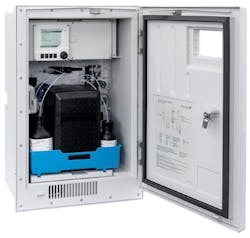Phosphorus Analyzer Provides Accurate Results Using Small Amounts of Reagent
The CA80TP phosphorus analyzer is designed for monitoring industrial wastewater, as well as inlet and outlet streams of municipal wastewater treatment plants. It measures phosphorus online in ranges of 0.05 to 10 mg/L or 0.5 to 50 mg/L. It includes two 4-20 mA outputs with the option for additional outputs. The 4-20 mA outputs transmit the phosphorus measurement value; the other outputs can be used to transmit the process variable, as well as status and diagnostic information.
Phosphorus occurs as phosphate in natural water systems and in wastewater. Phosphates enter the water from fertilizers, biological and industrial waste, and wastewater—and from substances added during water treatment for corrosion protection. Phosphate is a nutrient, so over-enrichment of phosphate (eutrophication) leads to excessive growth of aquatic plants. When these plants die in the fall, the decay of the additional biomass increases the rate of oxygen consumption. In extreme cases, this may lead to fish kills and decrease the quality of the water system.
To determine total phosphorus, a sample must be digested. Samples are drawn from the process using a suction strainer or taken from a bypass piping system using a Y strainer. A precise sample volume is digested at high temperature with a digestion reagent. An optical dosing unit, used to dose sample and reagents, uses a redundant light barrier for a high level of reliability, guaranteeing precise and reproducible results from extremely small volumes of reagent. The temperature in the reaction vessel is kept constant to ensure that complete digestion takes place within a short period of time. A software-controlled safety cover prevents access to the digestion reactor when it is under operation.
Following digestion, the sample is mixed with colorimetric analysis reagents, causing a characteristic change in the sample color. A photometer measures the level of absorption by the sample at defined wavelengths.
